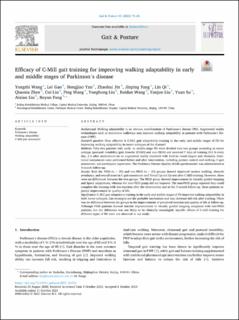| dc.contributor.author | Wang, Y. | |
| dc.contributor.author | Gao, L. | |
| dc.contributor.author | Yan, H. | |
| dc.contributor.author | Jin, Z. | |
| dc.contributor.author | Fang, J. | |
| dc.contributor.author | Qi, L. | |
| dc.contributor.author | Zhen, Q. | |
| dc.contributor.author | Liu, C. | |
| dc.contributor.author | Wang, P. | |
| dc.contributor.author | Liu, Y. | |
| dc.contributor.author | Wang, R. | |
| dc.contributor.author | Liu, Y. | |
| dc.contributor.author | Su, Y. | |
| dc.contributor.author | Liu, A. | |
| dc.contributor.author | Fang, B. | |
| dc.date.accessioned | 2022-08-25T11:07:26Z | |
| dc.date.available | 2022-08-25T11:07:26Z | |
| dc.date.issued | 2022 | |
| dc.identifier.citation | Wang, Y., Gao, L., Yan, H., Jin, Z., Fang, J., Qi, L., et al. (2022). Efficacy of C-Mill gait training for improving walking adaptability in early and middle stages of Parkinson’s disease. Gait Posture 91, 79–85. | en_US |
| dc.identifier.uri | https://hdl.handle.net/11250/3013521 | |
| dc.description.abstract | Background
Walking adaptability is an obvious manifestation of Parkinson’s disease (PD). Augmented reality technologies such as interactive walkways may improve walking adaptability in patients with Parkinson’s Disease (PWP).
Research question
How effective is C-Mill gait adaptability training in the early and middle stages of PD for improving walking adaptability in motor subtypes of the disease?
Methods
Fifty-two patients with early- or middle-stage PD were divided into two groups according to motor subtype (postural instability/gait disorder [PIGD] and non-PIGD) and received 7 days of training (0.5 h every day, 2 h after medication) on an augmented reality treadmill with built-in visual targets and obstacles. Functional assessments were performed before and after intervention, including posture control and walking, C-gait assessment, and participant experience. The Parkinson Disease Quality of Life questionnaire was administered at 3-month follow-up.
Results
Both the PIGD (n = 29) and non-PIGD (n = 23) groups showed improved tandem walking, obstacle avoidance, and overall score in C-gait assessment and Timed Up and Go test after C-Mill training. However, there were no differences between the two groups. The PIGD group showed improvement in visually guided stepping and Speed adaptations, whereas the non-PIGD group did not improve. The non-PIGD group reported they could complete the training with less exertion after the intervention and at the 3-month follow-up, these patients reported improvement in quality of life.
Significance
C-Mill gait adaptation training in the early and middle stages of PD improves walking adaptability in both motor subtypes. Cue strategies are the probable mechanism and may decrease fall risk after training. There was no difference between the groups in the improvements of perceived exertion and quality of life at follow-up. Although PIGD patients showed statistic improvements in visually guided stepping compared with non-PIGD patients, but the difference was not likely to be clinically meaningful. Specific effects of C-mill training for different types of PD were not observed in our study. | en_US |
| dc.publisher | Gait & Posture | en_US |
| dc.subject | Parkinson’s disease | en_US |
| dc.subject | Walking adaptability | en_US |
| dc.subject | C-Mill gait assessment | en_US |
| dc.subject | nevrologiske tilstander | en_US |
| dc.title | Efficacy of C-Mill gait training for improving walking adaptability in early and middle stages of Parkinson’s disease | en_US |
| dc.type | Journal article | en_US |
| dc.source.pagenumber | 79-85 | en_US |
| dc.source.volume | 91 | en_US |
| dc.source.journal | Gait & Posture | en_US |
| dc.identifier.doi | https://doi.org/10.1016/j.gaitpost.2021.10.010 | |
| dc.description.localcode | måsjekkes | |
